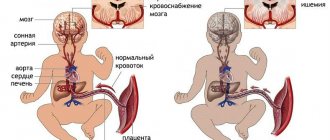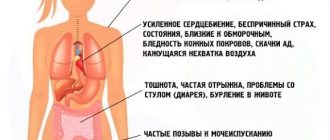During pregnancy, the fetus is closely connected to the mother through a special formation - the umbilical cord. Through it, he receives everything necessary for life and development - oxygen and nutrients.
Many pregnant women learn during an ultrasound examination that the umbilical cord has 3 vessels. They begin to worry and wonder: “Is this normal?” In this article we will answer it and tell you everything about the umbilical cord, including its possible pathologies. We hope you find this information useful.
What is the umbilical cord? What is its structure?
The umbilical cord (otherwise known as the umbilical cord) is a special formation that connects the fetus and the baby's place and allows for fetoplacental blood circulation. Outwardly, it resembles a spirally twisted bundle or cord and has a bluish-gray color. At the end of the third trimester, the umbilical cord reaches 50-60 cm in length, and its diameter at the umbilical ring is 1-2 cm. Although significant deviations from the average values in one direction or another can be observed. This is what the umbilical cord looks like. The photo demonstrates this.
One end of the umbilical cord is attached to the placenta, and the other to the baby in the area of the umbilical ring. It can be attached to the child's seat in different places, including in the center, on the side or on the edge. Rarely, the umbilical cord may attach to the membranes, some distance from the edge of the placenta. In this case, its vessels reach the child's place, passing between the membranes. Throughout its entire length, the umbilical cord has bends, depressions and bulges that arise due to its structural features. Normally, the umbilical cord has 3 vessels, two of them are umbilical arteries, and one is a thin-walled, wide-lumen umbilical vein. Nerve fibers are located along them. The nerves and vessels of the umbilical cord are surrounded by a special jelly-like connective tissue called Wharton's jelly. It performs a protective function, preventing compression of the arteries. The umbilical cord is covered on the outside with amnion, which, not reaching 0.5-1 cm from the navel, is transformed into the skin of the fetus.
Where is the norm and where is the pathology?
The umbilical cord (otherwise known as the umbilical cord) is a special formation that connects the fetus and the baby's place and allows for fetoplacental blood circulation. Outwardly, it resembles a spirally twisted bundle or cord and has a bluish-gray color. At the end of the third trimester, the umbilical cord reaches 50-60 cm in length, and its diameter at the umbilical ring is 1-2 cm. Although significant deviations from the average values in one direction or another can be observed. This is what the umbilical cord looks like. The photo demonstrates this.
One end of the umbilical cord is attached to the placenta, and the other to the baby in the area of the umbilical ring. It can be attached to the child's seat in different places, including in the center, on the side or on the edge. Rarely, the umbilical cord may attach to the membranes, some distance from the edge of the placenta. In this case, its vessels reach the child's place, passing between the membranes.
Throughout its entire length, the umbilical cord has bends, depressions and bulges that arise due to its structural features. Normally, the umbilical cord has 3 vessels, two of them are umbilical arteries, and one is a thin-walled, wide-lumen umbilical vein. Nerve fibers are located along them. The nerves and vessels of the umbilical cord are surrounded by a special jelly-like connective tissue called Wharton's jelly.
The most common pathologies encountered in clinical practice are entanglement of the umbilical cord around the neck, body and limbs of the fetus and significant shortening of the umbilical cord. An absolutely short (less than 40 cm) umbilical cord does not allow the baby to move normally, which leads to its incorrect position in the uterus.
During childbirth, it is overly stretched, as a result of which blood flow in the umbilical cord vessels is disrupted. It prevents the fetus from moving through the birth canal, which can lead to hypoxia. Sometimes the short umbilical cord or its vessels rupture, which can cause the death of the child. Entanglement can occur with any length of the umbilical cord.
It can be different - single or multiple, tight or loose, isolated or combined. Tight repeated clasping of the child's neck or torso disrupts blood circulation, leads to a lack of oxygen and threatens premature detachment of the child's place. In this case, the woman in labor is offered a method of delivery using a cesarean section.
We know that the umbilical cord normally has 3 vessels. But sometimes there are anomalies in the number of veins and arteries. 5% of multiple pregnancies and about 1% of singleton pregnancies are complicated by a pathology in the structure of the umbilical cord, which has only two blood vessels (one artery and one vein) instead of three. The cause of this anomaly in the structure of the umbilical cord has not yet been identified.
The absence of one umbilical artery worsens fetoplacental blood circulation. This can lead to various birth defects of the fetus, including heart defects, disruption of the genitourinary system and the baby’s central nervous system. Aplasia, that is, the complete absence of the umbilical cord, is extremely rare. In this case, the fetus is directly connected to the placenta and its development is seriously impaired.
Sometimes other pathologies are encountered in clinical practice, including umbilical vein aneurysms, embryonic umbilical cord hernia, true and false nodes, cysts, etc.
The umbilical cord is a cord that connects the fetal surface of the placenta to the abdominal wall of the fetus. Its main components are blood vessels. On the outside, the umbilical cord is covered with a single layer of epithelial cells, and the vessels are surrounded by a jelly-like substance (Wharton's jelly), which plays a protective role, enveloping them on all sides.
By the end of pregnancy, the thickness of the umbilical cord reaches one and a half to two centimeters, the length is cm, which allows the fetus to move freely in the uterine cavity even before birth, and the expectant mother feels peculiar tremors and movements. An excessively long or short umbilical cord is a sign of pathology.
The umbilical arteries exist only during fetal development. Departing from the internal iliacs, they pass along the inner surface of the abdominal wall, on the sides of the bladder in the form of a triangle, heading to the umbilical ring, where they are included in the umbilical cord. After birth, these vessels become empty, and only thin folds of peritoneum on the back of the abdominal wall remind of them.
There is only one umbilical vein, although initially there are two of them (the left one is reduced). Nature provides that only one vessel is sufficient to ensure adequate blood flow, so neither the fetus nor the mother experiences “inconvenience” due to an azygos vein. The umbilical vein delivers about 80% of the blood to the developing baby's inferior vena cava, and the remaining 20% is used for blood flow to the liver.
Uteroplacental blood flow system
The amount of blood that flows through the vessels of the umbilical cord during pregnancy is enormous. By the end of gestation, the fetus receives about 240 ml of arterial blood per minute through the vein, the same volume goes through the arteries to the placenta. About 5-20 minutes after the birth of a child, blood flow through the vessels of the umbilical cord remains, and at this time it can be taken for research and other purposes (preparation of medicines, for example), however, already during the birth process, under the influence of the release of the hormone oxytocin, the vessels of the umbilical cord begin to empty, and the organ quickly atrophies as unnecessary.
Around the 21st week of gestation, all pregnant women are sent for a Doppler study, which allows one to evaluate not only the anatomical features of the fetus, placenta, and umbilical cord, but also the characteristics of blood flow (speed, number of vessels, anomalies). Often doctors do not bother to explain the results of the analysis to the patient, even briefly, so expectant mothers scour the literature and the Internet in search of answers.
Normally, at any stage of pregnancy, the umbilical cord has 3 vessels. Having received such a conclusion, the woman can calm down - the blood flow is fine (of course, if no other anomalies are found). In some cases, the ultrasound diagnostic doctor does not detect one artery in the umbilical cord, then the conclusion will indicate that there are only two vessels - one vein and one artery.
If there is an insufficient number of umbilical cord vessels, specialists will have to figure out whether the anomaly is isolated or combined with other defects, which is often found in this type of pathology. Some women note that the number of vessels during ultrasound differs at different times, and this creates even more questions, misunderstanding and unnecessary anxiety for the expectant mother.
Note that the number of vessels should not change throughout pregnancy, so there are two conclusions: either one of the arteries stopped functioning for some reason, or an error was made in one of the studies, and it is necessary to “recount” the vessels again, preferably – from a competent and experienced doctor who will dispel all doubts.
We suggest you read: Which foods contain a lot of uric acid?
the child is absolutely healthy
The child was born healthy, only a little premature.
I was worried too, but in the end everything was ok)
By the way, I went. They said that, apart from other markers (and I have no other risks), this is considered a feature rather than a pathology. In general, they calmed me down.
The most common abnormality is a single artery in the umbilical cord. This does not mean that there is only one vessel. It’s just that only one of the two arteries is present. Thus, the diagnosis “single artery in the umbilical cord” implies that there are still two vessels - a vein and one artery. Blood enriched with nutrients moves through the vein to the baby, and through the artery, blood contaminated with metabolic products leaves the child’s body. In principle, one artery copes with the task, but experiences significant overload.
The cause of the abnormal structure of the umbilical cord is often the mother’s diabetes, as well as the presence of chronic diseases of the kidneys, heart, and liver. Other unfavorable factors can also affect the formation of umbilical cord structures - bad habits, infectious diseases, sexually transmitted diseases, influenza or ARVI in early pregnancy, as well as causes of unclear etymology, which cannot be determined.
This anomaly has no symptoms, does not affect the course of pregnancy, and in 95% of cases allows a woman to carry her baby to term quite normally and give birth to a child. In the singular, the artery may be formed initially, or it may remain the only one as a result of aplasia of the second artery already during pregnancy.
A single artery may be due to a genetic predisposition (the baby’s mother or father developed such a pathology during pregnancy), and in some cases, the presence of a single artery may indicate chromosomal abnormalities in the fetus or congenital malformations of its respiratory system, intestines, heart or kidneys .
That is why, when one artery is detected instead of the normal two, doctors more carefully examine the baby for possible defects and deviations in development and formation - they conduct an expert ultrasound, recommend invasive diagnostics or a non-invasive prenatal DNA test, which can detect fetal blood cells in the bloodstream mothers to determine the baby’s DNA and possible chromosomal pathologies.
At risk for developing single umbilical cord artery syndrome are women with diagnosed polyhydramnios and multiple pregnancies, with severe early toxicosis, placental pathologies, and obesity. If the fact of the presence of a single artery in the umbilical cord is confirmed, the woman will under no circumstances be recommended to terminate the pregnancy; there are no medical indications for this.
If additional studies show that the child is healthy, then the pregnant woman will be monitored as usual, although they will have to do ultrasound with Doppler more often to assess blood flow, and in the later stages, CTG to assess the condition of the fetus.
Arteries and vein of the umbilical cord. What are their functions?
So, we learned that normally the umbilical cord has 3 vessels. The two umbilical arteries originate from the internal iliac arteries.
They transport the child's blood with carbon dioxide and metabolic products to the child's place. In the placenta, it is saturated with oxygen and nutrients necessary for the fetus. The blood is also freed from carbon dioxide and metabolic products. Further along the umbilical vein it returns back to the child. About 80% of all blood is delivered to the baby’s systemic circulation through the duct of Arantius, which runs along the lower surface of the liver and flows into the inferior vena cava. The remaining blood (about 20%) is sent to the portal circulation between the portal and umbilical veins, through the anastomosis. It supplies blood to the baby's liver.
The only artery of the umbilical cord
One end of the umbilical cord is attached to the placenta, and the other to the baby in the area of the umbilical ring. It can be attached to the child's seat in different places, including in the center, on the side or on the edge.
DETAILS: Leg blood vessels clogged for 30 treatments
Rarely, the umbilical cord may attach to the membranes, some distance from the edge of the placenta. In this case, its vessels reach the child's place, passing between the membranes. Throughout its entire length, the umbilical cord has bends, depressions and bulges that arise due to its structural features.
Normally, the umbilical cord has 3 vessels, two of them are umbilical arteries, and one is a thin-walled, wide-lumen umbilical vein. Nerve fibers are located along them. The nerves and vessels of the umbilical cord are surrounded by a special jelly-like connective tissue called Wharton's jelly.
So, we learned that normally the umbilical cord has 3 vessels. The two umbilical arteries originate from the internal iliac arteries. They transport the baby's blood with carbon dioxide and metabolic products to the baby's place.
In the placenta, it is saturated with oxygen and nutrients necessary for the fetus. The blood is also freed from carbon dioxide and metabolic products. Further along the umbilical vein it returns back to the child.
About 80% of all blood is delivered to the baby’s systemic circulation through the duct of Arantius, which runs along the lower surface of the liver and flows into the inferior vena cava. The remaining blood (about 20%) is sent to the portal circulation between the portal and umbilical veins, through the anastomosis. It supplies blood to the baby's liver.
The umbilical cord is the main highway that provides blood flow with substances, microelements and oxygen vital for the fetus from the mother and removes waste blood. It connects the placenta (baby place) with the anterior abdominal wall of the fetus and consists of three vessels covered with a special protective membrane (Wharton's jelly).
Through the umbilical vein, the fetus receives oxygen and all the nutrients necessary for its normal development. Two umbilical arteries carry out the outflow of blood saturated with carbon dioxide and metabolic products back to the placenta.
An anomaly in the structure of the umbilical cord, when instead of two arteries one is formed, is called a single umbilical cord artery.
The absence of one artery in the umbilical cord can be initial (congenital aplasia) or develop during pregnancy (artery atrophy, which occurs as a result of the complete cessation of its functioning).
A single fetal umbilical cord artery is considered a fairly common pathology: 1 in 200 singleton pregnancies – 0.5% and 1 in 20 multiple pregnancies – 5%.
Normally, the umbilical cord contains 2 arteries and 1 vein
In obstetrics, this umbilical cord anomaly is defined as single umbilical artery syndrome. The likelihood of its occurrence increases with diabetes mellitus, multiple pregnancies and other complex diseases in the expectant mother (pathology of the kidneys, liver, heart and blood vessels).
The reasons for the development of single umbilical cord artery syndrome are conditions and factors that negatively affect the formation of blood vessels and tissue differentiation in the early stages of intrauterine development.
Bad habits in a pregnant woman can cause pathology
The causes of umbilical cord vascular anomalies are not fully understood, but the most common predisposing and provoking factors are:
- chromosomal abnormalities (aberrations);
- severe somatic and infectious diseases of the expectant mother in the first trimester of pregnancy;
- intoxication;
- diabetes;
- bad habits (smoking, alcohol abuse, taking narcotic and other potent drugs);
- exposure to radiation, unfavorable environmental conditions, occupational hazards at work;
- multiple pregnancy.
The most dangerous period of intrauterine development with a high risk for the occurrence of congenital vascular anomalies of the placenta is considered to be 6-9 weeks of gestation - the period of formation of the future placenta.
Atrophy of a functioning umbilical cord artery can occur due to thrombosis, compression by a tumor (teratoma, hemangioma) or hematoma, or when nodes appear in one artery. These conditions occur extremely rarely under the influence of several pathological factors and require constant dynamic monitoring of the condition of the fetus and the expectant mother.
In most cases, there are no clinical signs of the presence of this anomaly, and diagnosis is carried out by instrumental examination methods:
- screening (routine) or urgent ultrasound;
- Dopplerometry - determination of the main indicators of blood flow in the umbilical cord.
Ultrasound will help diagnose pathology
The presence of this pathology can be determined at 20-21 weeks of pregnancy by ultrasound examination of the umbilical cord in cross section. Diagnosis is made with a full bladder.
If a pathology is detected, an additional examination is prescribed - Doppler ultrasound to clarify the absence of weakening of blood flow.
After identifying a vascular anomaly of the umbilical cord in the fetus, constant monitoring of the course of pregnancy is necessary until the moment of birth. Repeated regular Doppler examinations are carried out in order to promptly diagnose changes in blood flow in the umbilical cord artery and avoid complications of the fetal condition.
In 70% of cases, this condition does not have a negative effect on the intrauterine and postpartum condition of the child - a single artery completely copes with the increased load. Diagnosing this defect in most cases is not a cause for concern.
We advise you to read: At what week can you hear the fetal heartbeat?
- Chromosomal diseases.
- Congenital malformations: heart and blood vessels; urinary system; abdominal and thoracic organs.
Therefore, when diagnosing a single umbilical cord artery, it is necessary to conduct a comprehensive examination of the fetus to exclude the presence of other anomalies.
It is important to remember that isolated single umbilical cord artery syndrome is not an indication for termination of pregnancy and is not considered a marker of Down syndrome and other chromosomal diseases.
But the combination of this pathology with other developmental defects has a high risk for the life and further development of the child.
Consequences of combined developmental defects:
- intrauterine fetal death (frozen pregnancy);
- intrauterine growth retardation (IUGR);
- chronic intrauterine fetal hypoxia;
- intrauterine hypotrophy.
A single umbilical cord artery may be the cause of chronic fetal hypoxia and related consequences
The most important points in the presence of single umbilical artery syndrome are:
- Constant dynamic monitoring of the course of pregnancy by an obstetrician-gynecologist.
- Complete examination of the pregnant woman and fetus upon initial detection of pathology.
- Necessary additional instrumental studies: additional ultrasound at 28 weeks and routine examination at 32-34 weeks of pregnancy; dopplerometry.
- In case of any pathological changes in the condition of the expectant mother, disturbances in blood flow in the vessels of the umbilical cord, or detection of signs of intrauterine growth retardation, it is recommended that the pregnant woman be kept in a hospital under round-the-clock supervision of specialists.
A child born with such a pathology requires careful monitoring for timely diagnosis of possible abnormalities.
Many pregnant women, after diagnosing this anomaly, are at a loss. They do not know what to do and how this pathology can affect the intrauterine development and health of the baby in the future.
DETAILS: CTG norms decoding 33 weeks
First of all, you need to calm down and understand that the only artery of the umbilical cord carries an increased load, and unnecessary worries, hard work and stress have an extremely negative effect on blood flow.
Therefore it is very important:
- maintain a certain daily routine;
- completely eliminate any psycho-emotional stress;
- free yourself from heavy work and heavy lifting;
- to walk outside;
- prevent the development of constipation.
In most cases, one umbilical cord artery rarely affects the health of the child in the future, and the birth of a baby with developmental abnormalities when this anomaly is diagnosed is extremely rare. If you follow all the recommendations of specialists and constantly monitor the condition of the fetus, the number of umbilical cord arteries does not matter at all for the child’s future life.
An anomaly in the structure of the umbilical cord, when instead of two arteries one is formed, is called a single umbilical cord artery.
The umbilical cord is the main highway that ensures the flow of blood with vital substances for the fetus, microelements and oxygen from the mother and the removal of waste blood.
It connects the placenta (baby place) with the anterior abdominal wall of the fetus and consists of three vessels covered with a special protective membrane (Wharton's jelly).
Through the umbilical vein, the fetus receives oxygen and all the nutrients necessary for its normal development.
Two umbilical arteries carry out the outflow of blood saturated with carbon dioxide and metabolic products back to the placenta.
Therefore, the presence of structural features or anomalies of the umbilical cord have a great impact on the viability and dynamics of fetal development, as well as on the outcome of pregnancy.
The umbilical cord of a newborn. What happens to her after the baby is born?
After birth, the newborn's umbilical cord is clamped and then cut. A ligature or a metal Rogovin staple is applied to the remaining part of the umbilical cord adjacent to the child’s umbilical area. After some time, the staple is removed, and the remainder of the umbilical cord is removed by cutting, retreating 2-3 cm from the dressing site. A gauze pad is placed near the umbilical ring.
During the third stage of labor, the woman gives birth to the remaining portion of the umbilical cord along with the placenta and fetal membranes. After the baby is born, the muscles of the arteries contract reflexively, the vessels empty and close, and blood circulation in them stops. This clever natural mechanism prevents the possibility of blood loss to a newborn if its umbilical cord remains untied. Subsequently, the vessels turn into scar cords.
Methods for studying the condition of the umbilical cord
In general, the condition of the umbilical cord and its possible pathologies are quite difficult to detect during pregnancy. As a rule, ultrasound diagnostics are performed, which makes it possible to identify the entanglement of the umbilical cord around the neck, limbs and torso of the fetus, as well as its presentation. With the help of phonocardiography and auscultation, not only heart defects can be detected, but also the murmur of the umbilical cord vessels, which appears in connection with the entanglement of the child’s torso or neck. Doctors can also use the color mapping method, in which all umbilical arteries, veins and Doppler measurements are clearly visible, allowing one to assess, among other things, the state of the uteroplacental blood flow. Vaginal examination reveals prolapse of the umbilical cord loops. After the birth of the placenta, the placenta and umbilical cord are examined and, if necessary, the material is sent for histological examination.
What to do if there is not enough vessel in the umbilical cord?
So, summing up the above, we note that an anomaly in the number of umbilical cord vessels can be isolated, without other disorders in the developing fetus, and combined with other defects, the likelihood of which is quite high.
In case of an isolated umbilical cord defect, the expectant mother should calm down and promptly undergo all studies, including additional ultrasound control. If there are no other abnormalities, it means that the baby is developing correctly, the blood flow is adequate, and additional examinations, including cordocentesis and genetic consultation, are not required.
If abnormalities in the fetus are detected against the background of EAP, a thorough examination is indicated:
- Additional ultrasound with Doppler measurements at different stages of gestation;
- Cordocentesis and karyotyping to search for chromosomal mutations;
- Genetic consultation.
In the case of severe defects, the issue of termination of pregnancy is resolved, but it is worth remembering the higher frequency of spontaneous miscarriages and stillbirths with such an anomaly. Child mortality with severe anatomical defects in the structure of organs at an early age, according to some data, reaches 10-14%.
For any pathology of the umbilical cord vessels, you should first of all consult a doctor, and not look for answers on dubious children's sites and forums on the Internet or among familiar mothers who “know everything” about pregnancy. Of course, for the majority of isolated EAP the course is favorable, as evidenced by the birth of a large number of healthy babies, but in order to be confident in the well-being of your child, it is worth going through all the examinations necessary for this diagnosis.
First of all, pregnant women who at 20 weeks heard an ultrasound verdict of “single umbilical artery” are advised to calm down and not escalate the situation. One artery is a sign of congenital malformations of the fetus or chromosomal pathologies (Down syndrome, Patau and others) only in 1-1.5% of cases when such a structural anomaly of the umbilical cord is detected.
Women with a single umbilical cord artery and a healthy fetus are advised to visit the doctor more often, as well as to follow certain safety measures that will prevent excessive stress on the single vessel. The consequences of the load can be quite significant - this is delayed fetal development, malnutrition, low weight, the threat of premature birth due to developed fetoplacental insufficiency, fetal hypoxia.
First of all, increased blood pressure is dangerous for the expectant mother and her baby. A woman needs to closely monitor it, measure it daily, and for hypertension undergo appropriate treatment with drugs approved and recommended by a doctor. To avoid sudden surges in blood pressure, it is recommended to limit any stress, conflicts, worries, or emotional outbursts.
To maintain normal blood flow, the expectant mother is advised to avoid any heavy work, especially those involving heavy lifting and long periods of standing or sitting in one position. Sex and walking should be moderate, gentle, and not exhausting.
A woman with a single artery in the umbilical cord structure should not smoke, take even small doses of alcohol, or stay in a stuffy room for a long time - access to oxygen is extremely necessary for the mother and her baby.
A woman’s diet must be rich in vitamins; in addition, she may need to take vitamin complexes so that the baby does not need the nutrients he needs. Otherwise, a pregnancy with single umbilical artery syndrome will be no different from a pregnancy with a normal umbilical cord. Reviews from doctors and patients allow us to safely say that there is nothing wrong with this anomaly.
For more information about what the diagnosis “Single umbilical cord artery” means, see the following video.
Tags: threaten, umbilical cord, vessel
About the author: admin4ik
« Previous entry
Umbilical cord pathologies. entwinement
The most common pathologies encountered in clinical practice are entanglement of the umbilical cord around the neck, body and limbs of the fetus and significant shortening of the umbilical cord. An absolutely short (less than 40 cm) umbilical cord does not allow the baby to move normally, which leads to its incorrect position in the uterus. During childbirth, it is overly stretched, as a result of which blood flow in the umbilical cord vessels is disrupted. It prevents the fetus from moving through the birth canal, which can lead to hypoxia. Sometimes the short umbilical cord or its vessels rupture, which can cause the death of the child. Entanglement can occur with any length of the umbilical cord. It can be different - single or multiple, tight or loose, isolated or combined. Tight repeated clasping of the child's neck or torso disrupts blood circulation, leads to a lack of oxygen and threatens premature detachment of the child's place. In this case, the woman in labor is offered a method of delivery using a cesarean section.
Anomalies in the structure of the umbilical cord
We know that the umbilical cord normally has 3 vessels. But sometimes there are anomalies in the number of veins and arteries. 5% of multiple pregnancies and about 1% of singleton pregnancies are complicated by a pathology in the structure of the umbilical cord, which has only two blood vessels (one artery and one vein) instead of three. The cause of this anomaly in the structure of the umbilical cord has not yet been identified. The absence of one umbilical artery worsens fetoplacental blood circulation. This can lead to various birth defects of the fetus, including heart defects, disruption of the genitourinary system and the baby’s central nervous system. Aplasia, that is, the complete absence of the umbilical cord, is extremely rare. In this case, the fetus is directly connected to the placenta and its development is seriously impaired.
Sometimes other pathologies are encountered in clinical practice, including umbilical vein aneurysms, embryonic umbilical cord hernia, true and false nodes, cysts, etc.
Two vessels in the umbilical cord. Is it dangerous?
List of messages in the topic “2 vessels in the umbilical cord” forum Pregnancy {amp}gt;
Pregnancy How many vessels should the umbilical cord have - a “conductor” connecting the fetus with the mother during pregnancy, a supplier of nutrients and oxygen. Dopplerometry of the umbilical cord vessels is among the studies required for women who are preparing for motherhood.
The procedure is carried out at 21 weeks, with its help the number of arteries is determined. The study allows you to timely identify abnormalities in the development of the embryo and take the necessary measures.
If, in the results of Dopplerometry, the expectant mother discovers that the umbilical cord has 3 vessels - what does this mean? If 2 vessels are diagnosed in the umbilical cord, what threat does this pose to the embryo?
To understand why the umbilical cord has 3 vessels and what this means, you need to understand its structure. This is the name given to a kind of “rope” that ensures the connection between the embryo and the mother’s body and the interaction of the circulatory systems.
The formation of the connecting element is completely completed by approximately 12 weeks. The length of the formation is cm, “used” before the birth of the child. Normally, it is adjacent to the middle part of the placenta; there are exceptions (for example, membrane attachment).
How many vessels should there be in the umbilical cord? The norm is 2 arteries and one vein – 3 vessels. The vein serves as a conductor through which oxygenated blood penetrates the baby’s circulatory system from the woman’s body.
Nutrients also leak into the vein through the vein. Arteries are used to remove waste products. 3 vessels in the umbilical cord during pregnancy indicate no cause for concern.
The norm that the umbilical cord must meet is 3 vessels, what this means can be read above. However, sometimes there is a deviation from this rule - two vessels in the umbilical cord. Expectant mothers are forced to face the medical verdict “EAP”, which stands for “single artery” of the umbilical cord, in about 0.5% of cases.
2 vessels in the umbilical cord - what does this mean, if there is a reason for concern? One of the arteries may be absent immediately, or its functionality may be impaired while waiting for the baby. EAP does not belong to the category of diagnoses that are fatal to the fetus, but requires additional research.
So, the umbilical cord has 2 vessels - what does this mean for the baby? In approximately 90% of cases, EAP pathology is an isolated abnormality and does not turn into a threat to the fetus and mother. Despite the increasing load placed on the vessel, its functioning is not impaired. A small baby is born in about 13% of cases.
The umbilical cord vessels (2 or 3) are not of significant importance at the stage of childbirth. The main thing is that the specialist and junior medical staff attending the birth are aware of the presence of pathology. Labor management tactics, selected specifically for such a case, guarantee that there is no danger for the woman in labor and the fetus.
2 vessels in the umbilical cord - what are the dangers of deviation from the recognized norm during the birth process? If it is carried out incorrectly, hypoxia of the embryo is possible (lack of oxygen, complete interruption of its supply).
The umbilical cord has 2 vessels - what does this mean according to doctors? In such situations, obstetricians-gynecologists necessarily insist on additional examination, which is prescribed to the pregnant woman.
It’s great if there are 3 vessels in the umbilical cord. However, timely diagnosis of deviations from this norm allows one to avoid risk even with one artery. The gynecologist must prescribe an additional examination to the woman to make sure that there are no other genetic pathologies that develop against the background of the disorder.
The number of vessels in the umbilical cord, normality or pathology - these questions can be clarified already by the 20th week, when the pregnant woman can undergo Dopplerometry. Most often, the umbilical cord has 3 vessels at 20 weeks. If, as a result of the study, it is determined that the number of arteries is not normal, Doppler testing is indicated for the expectant mother until birth. The procedure will provide control of blood flow in the vessels and will allow recording deviations.
Knowing how many vessels there should be in the umbilical cord, when diagnosing a disorder, it is worth consulting with a geneticist. An examination carried out by this specialist will help to reject the assumption of chromosomal abnormalities.
A pregnant woman is advised to test blood obtained from the umbilical cord (cardocentesis). An ultrasound of the embryo's heart is required to rule out heart pathology, up to a week. Prevention tools - ultrasound of organs (each), cardiotocography (CTG).
How many vessels are in the umbilical cord is a question, the answer to which is absolutely unimportant for the future life of the child. The diagnosis of EAP only indicates the need for additional examinations. A threat arises only when other chromosomal abnormalities that can harm the fetus are attached to a single artery.
My youngest son had two vessels instead of three... She carried it normally, although she often went for ultrasounds to monitor the baby’s development. Everything went well, she also gave birth without complications. The weight was 3.900. He grew and developed well...
But! When he began to grow up, it was as if he had developmental delays. He only spoke when he was 4 years old. Now he is 7. He has bad memory. We tried to go to different clubs, but he couldn’t do it, he couldn’t remember anything….
He can’t even write simple poems, he can’t do addition or subtraction either... He’s absent-minded, he always has to be reminded of everything, he even forgets his briefcase, he also constantly stumbles and falls... I don’t know if this is somehow connected with his intrauterine development, but he’s the only one I have Here….
I was observed by a doctor throughout my pregnancy and gave birth on my own, quickly and without complications. Weight and height are good. The child is very active, has a good memory, at the age of 6 he reads, writes, and counts; his son’s development is simply excellent.
She is ahead of her peers, which I am very happy about, because I read that children with two vessels, on the contrary, lag behind... but there is one thing... vision fails -5, -7 and a whole bunch of diseases associated with the eyes. We get treatment and go for procedures, but in general everything is fine with health, I rarely get sick.
My daughter also had 2 vessels, she gave birth on her own, the birth went well, her height was normal, but her nails were too short, and today she is three years old and her nails still don’t grow, but only along with her fingers, we don’t cut them, on her toes nails are not beautiful, deformed((((
DETAILS: Plaques in the blood vessels of the brain
Experts believe that 2 vessels in the umbilical cord are a sign of a pathological pregnancy. In most cases, the doctor will advise the woman to undergo a series of tests that can confirm whether the baby has chromosomal abnormalities. For example, amniocentesis may be recommended.
In the case of EAP, the woman will be forced to repeatedly conduct Doppler examination of the umbilical cord vessels. In almost 90% of cases, pregnancy, in which the umbilical cord has two vessels, is no longer accompanied by any other abnormalities and childbirth takes place as usual.
The main thing that a pregnant woman should know is that nerves greatly affect the child’s condition. If you have been diagnosed with EAP, and the baby does not have any developmental defects or chromosomal abnormalities, do not worry. It is enough to control your condition, find a competent gynecologist and hope for the best.
This article contains general information only and is not intended to substitute for advice from a qualified professional.
Mobile application “Happy Mama” 4.7 Communicating in the application is much more convenient!
Question
I am 22 years old. Pregnancy 22 weeks. An ultrasound showed that there were two vessels in the umbilical cord, instead of the required three. What does this threaten, what is it?
Aplasia of one of the umbilical cord arteries most often does not affect the development of the baby, but during childbirth it can cause acute hypoxia of the fetus and even its death. Therefore, in such situations, it is better to perform a caesarean section in the interests of the fetus.
I have a healthy baby, just keep a good eye on the midwife and ultrasound
After an ultrasound, many women are frightened by the doctor’s conclusion that the umbilical cord has 2 vessels instead of three, as it should be. Doctors do not always provide detailed information, but expectant mothers are very concerned about how this can harm the child and what can be done to avoid the consequences.
The umbilical cord (umbilical cord) is an organ that connects the fetus to the mother’s body; it reaches a length of cm or more. The umbilical cord must have three vessels, namely: two arteries and one vein. With aplasia (improper development) of one umbilical cord artery, an anomaly occurs - the umbilical cord of 2 vessels, i.e.
one artery and one vein. The artery carries fetal blood, saturated with carbon dioxide, and waste metabolic products to the maternal placenta. The umbilical vein carries blood, which is rich in oxygen and nutrients, from the mother's placenta to the baby.
During childbirth, 2 vessels in the umbilical cord can cause fetal hypoxia, so a cesarean section is indicated in such cases. During childbirth, the baby needs to be given maximum attention, since cutting the umbilical cord may interfere with blood flow.
During pregnancy, it is necessary to see a geneticist to rule out chromosomal abnormalities (the doctor usually suggests doing cardocentesis - a blood test taken from the umbilical cord). Also, up to 24 weeks, you need to do an ultrasound of the fetal heart (to prevent possible heart defects) and an extended ultrasound of all organs. In order to prevent violations, doctors prescribe CTG and Doppler once every two weeks.
Practice shows that the number of umbilical cord vessels rarely affects the future health of the child. And the birth of a baby with disabilities in this case is rather an exception: in the child’s later life, one artery has no significance.











